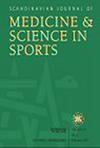Second Metatarsal Bone Stress During Running Is Independently Influenced by Running Speed and Load Carriage.
IF 3.8
2区 医学
Q1 SPORT SCIENCES
引用次数: 0
Abstract
Bone stress injuries occur in populations who engage in repetitive loading, such as distance runners and military recruits. The second metatarsal is a common bone stress injury site. Running speed and load carriage are modifiable factors which may influence metatarsal loading. The aim of this study was to determine how running at preferred, 90% of preferred, and 110% of preferred speed, with and without a weight vest carrying 10% body mass, influences second metatarsal bone stress. Data were collected from 28 runners (14 female, 14 male) during barefoot running using motion capture cameras, a pressure plate, and a force plate. Bone stress was calculated at the dorsal and plantar surfaces of the midshaft of the second metatarsal using a two-dimensional beam theory model. No interaction effect was found between running speed and load carriage. Running at 90% of preferred speed decreased peak dorsal and plantar stress by 2.1% and 2.3%, respectively, compared to preferred speed, while running at 110% of preferred speed increased peak dorsal and plantar stress by 4.2%. Running with 110% of body mass increased peak dorsal and plantar metatarsal stress by 3.1% and 2.9%, respectively, compared to running with no additional mass. The mean coefficient of variation across all conditions was 25%, indicating variation in peak stress between participants. Running at faster speeds and with additional loads may increase the risk of second metatarsal bone stress injury. The high variation in peak bone stress between participants demonstrates the importance of considering the individual when assessing injury risk.跑步时第二跖骨应力独立受跑步速度和负重的影响。
骨应力性损伤发生在从事重复性负荷的人群中,如长跑运动员和新兵。第二跖骨是常见的骨应激损伤部位。运行速度和载荷承载是影响跖骨载荷的可变因素。本研究的目的是确定以首选速度、90%首选速度和110%首选速度跑步,有或没有携带10%体重的重量背心,对第二跖骨应力的影响。使用动作捕捉相机、压力板和测力板收集了28名跑步者(14名女性,14名男性)赤脚跑步时的数据。采用二维梁理论模型计算第二跖骨中轴背侧和足底面骨应力。运行速度与载重量之间无交互作用。与首选速度相比,以90%的首选速度跑步可使峰值背应力和足底应力分别降低2.1%和2.3%,而以110%的首选速度跑步可使峰值背应力和足底应力增加4.2%。与没有额外体重的跑步相比,以110%的体重跑步会使背侧和足底跖骨峰值压力分别增加3.1%和2.9%。所有条件下的平均变异系数为25%,表明参与者之间的峰值压力存在差异。以更快的速度和额外的负荷跑步可能会增加第二跖骨应力损伤的风险。在参与者之间的峰值骨应力的高度变化表明了在评估损伤风险时考虑个体的重要性。
本文章由计算机程序翻译,如有差异,请以英文原文为准。
求助全文
约1分钟内获得全文
求助全文
来源期刊
CiteScore
7.90
自引率
4.90%
发文量
162
审稿时长
3 months
期刊介绍:
The Scandinavian Journal of Medicine & Science in Sports is a multidisciplinary journal published 12 times per year under the auspices of the Scandinavian Foundation of Medicine and Science in Sports.
It aims to publish high quality and impactful articles in the fields of orthopaedics, rehabilitation and sports medicine, exercise physiology and biochemistry, biomechanics and motor control, health and disease relating to sport, exercise and physical activity, as well as on the social and behavioural aspects of sport and exercise.

 求助内容:
求助内容: 应助结果提醒方式:
应助结果提醒方式:


